 Image search results - "Onsen" Image search results - "Onsen" |
|
|
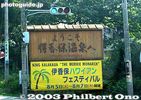
Ikaho is also a sister city of Hawaii island. During Aug. 5-7, 2003, Ikaho hosted the 7th King Kalakaua Merrie Monarch Hawaiian Festival featuring hula performances by numerous Japanese hula groups.
|
|

In the evenings, Hawaii's top hula halau (winner of the Merrie Monarch Festival in Hawaii) performed as the festival's main event. Photo: Flags of Hawaii and Ikaho town (merged with Shibukawa in 2006).
|
|

Town parking lot with a makeshift stage and main venue of the festival. The "Merrie Monarch" refers to King David Kalakaua who reigned over the Hawaiian Kingdom 1874-1891. He promoted hula in Hawaii as well as Japanese immigration to Hawaii.
|
|

Canopy for the spectators fronting the main outdoor stage.
|
|

Main stage where many Japanese hula troupes performed during the day for three days. Free admission.
|
|

Tahitian dances were also performed.
|
|

Hawaiian souvenirs for sale.
|
|

Ikaho is famous for the Stone Steps lined with shops. A section of it also served as a second hula stage during the day.
|
|

Hula on the Stone Steps 石段街
|
|

Hula workshops are also offered during the day at cost. A famous kumu hula teacher from Hawaii teaches the class.
|
|

Other workshops are held such as ukulele lessons and a lei-making class.
|
|

In the evenings, the overall winner of the annual Merrie Monarch Festival in Hawaii performed on stage. In 2003, it was Hula Halau 'O Kamuela from Oahu. They performed both the ancient hula kahiko dances (pictured here) and modern auana dances in Ikah
|
|

The Ikaho hula festival is officially sanctioned by The Merrie Monarch Festival, held in spring in Hilo, Hawaii. It is the most important and prestigious hula competition.
|
|

Hula is also performed by men. These photos were taken during the 7th Ikaho Hawaiian Festival (Aug. 5-7, 2003).
|
|
|
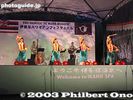
They wore a variety of colorful costumes and used various hula instruments such as these frayed bamboo sticks called Pūʻili.
|
|

Modern hula dances such as this one is mainly for tourist entertainment.
|
|
|
|
|
|

After the bamboo sticks, the girls used a gourd drum called ipu.
|
|

Finally, they use feathered gourd rattles called Ulīʻulī.
|
|
|
|
|

They are professional hula dancers, some of the best in the world.
|
|

The kumu hula is Kamana'o Anson Kauionalani or Kaui for short. He does a solo dance here. The music was performed by a wonderful Hawaiian trio called 'Ale'a.
|
|
|

Umi Jigoku (Ocean Hell) 海地獄
|
|

Lotus pond in Umi Jigoku
|
|

Umi Jigoku 海地獄
|
|

Umi Jigoku. A hell which can never freeze over. 海地獄
|
|

Umi Jigoku. 海地獄
|
|
|

Yama Jigoku (Mountain Hell) 山地獄
|
|

Hippo at Yama Jigoku (Mountain Hell) 山地獄
|
|

Kamado Jigoku かまど地獄
|
|

Mud spring 泥沼湯
|
|

Oniyama Jigoku (Ogre Mountain Hell) 鬼山地獄
|
|
|
|
|

Shiraike Jigoku (White Pond Hell) 白池地獄
|
|
|
|

Golden Dragon Hell 金壟地獄
|
|

Chinoike Jigoku (Blood Pond Hell) 血の池地獄
|
|

Chinoike Jigoku (Blood Pond Hell) 血の池地獄
|
|
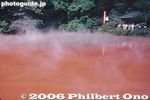
Chinoike Jigoku (Blood Pond Hell), Beppu, Oita 血の池地獄
|
|

Chinoike Jigoku 血の池地獄
|
|

Tatsumaki Jigoku (Tornado Hell) 龍巻地獄A short geyser.
|
|

Tatsumaki Jigoku (Tornado Hell) 龍巻地獄
|
|

Tatsumaki Jigoku (Tornado Hell) 龍巻地獄
|
|

Tatsumaki Jigoku (Tornado Hell) 龍巻地獄
|
|

JR Atami Station
|
|

Gift shops next to Atami Station. The architecture doesn't match the station at all.
|
|
|

In front of Atami Station.
|
|

Hot spring foot bath next to Atami Station.
|
|
|

Tokugawa Ieyasu's hot spring.
|
|

In front of Atami Station.
|
|

Onsen manju, sweet bean jam cakes steamed with hot spring water are sold everywhere in Atami.
|
|

Onsen manju
|
|
|

Entrance to shopping arcade.
|
|

Inside Heiwa-dori shopping arcade.
|
|

Hot spring fountain as a hand bath.
|
|

Lots of sloping roads in hilly Atami.
|
|

Directions
|
|
|
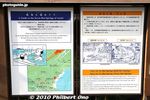
About Atami's seven hot springs
|
|

Atami Ginza is quite deserted during the day.
|
|

Atami Ginza is a street of shops.
|
|

Hawaiian restaurant in Atami Ginza.
|
|

Some cherry trees near the beach.
|
|
|

Rainbow Deck
|
|

Atami Sun Beach is popular in summer.
|
|

It takes about 20 min. to walk to the beach from Atami Station.
|
|

Imagine hpw crowded the beach will get when they have summer fireworks in Atami.
|
|
|
|

Atami Moon Terrace
|
|

The beachfront is a mishmash of buildings.
|
|
|

Water fountain for lovers.
|
|

Ferry
|
|

Hatsushima island
|
|

Ferries go to Hatsushima and Oshima islands.
|
|

Yacht harbor
|
|

Peninsula on the right side is unsightly with another mishmash of structures.
|
|

Fake castle in Atami, but a landmark nevertheless.
|
|

Plaque for Sir Rutherford Alcock, the first British ambassador to Japan and the first foreigner to climb Mt. Fuji. He stopped in Atami on the way back from Mt. Fuji.
|
|

Tacky bridges leading to the sleazy side of town.
|
|
|

Atami has a few hot spring public baths where you can enjoy the waters without having to stay at a hotel. It costs around 500 yen to 1000 yen.
|
|

Katahara Onsen Ajisai no Sato (形原温泉あじさいの里) Main gate 正面ゲ~ト
|
|

Ticket booth. Admission: ¥500 for adults and free for junior high schoolers and younger. In June, open 8:00 am to 9:00 pm. (Enter by 8:30 pm.)
|
|

Lots of visitors going up the hill of hydrangea.
|
|

The garden is on a hill with the front slope covered with hydrangea. The hilltop has Hodagaike Pond and walking paths lined with hydrangea.
|
|
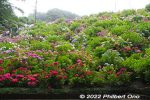
The garden is also illuminated at night, and you might even see fireflies if you're lucky.
|
|

Katahara Onsen Ajisai no Sato in Gamagori, Aichi in June. In June 2023 during the Hydrangea Festival, there is a bus that runs from JR Gamagori Station (south exit, bus stop No. 3) to Katahara Onsen (Ajisai no Sato) hydrangea garden. Bus fare is ¥390 one way. On weekdays, the bus runs once or twice an hour from 9:40 am to 2:50 pm. The last bus leaves Katahara Onsen at 3:15 pm. On weekends, it runs twice an hour from 9:25 am to 4:25 pm and the last bus leaves Katahara Onsen at 8:50 pm. The bus ride takes about 20 min.
|
|

Map of Ajisai no Sato hydrangea garden. Main entrance is on the right where the main road meets the slope of hydrangea. There's a walking path around the hilltop pond.Remember that June is the rainy season, so bring an umbrella in case it rains. Also see my blog post for more details: https://photoguide.jp/log/2023/06/katahara-onsen-ajisai-gamagori-aichi/
|
|

Hawai Onsen hot spring is on the western shore of Lake Togo, a small brackish lake in Yurihama town in central Tottori Prefecture. A 15-min. bus ride from JR Kurayoshi Station at this bus stop.
|
|

Lake Togo is a small brackish lake connected to the Sea of Japan through a 2 km river. The perimeter is 12 km, and there's a walking path. There are no swimming beaches.It is a rare lake in Japan to have hot spring water gushing out of the center of the lake. The warm water creates a misty lake surface in winter.
|
|

The lake has Togo Onsen on the south shore, while the smaller Hawai Onsen is on the western shore. The lake has been in its current shape since at least the 13th century.
|
|

Hakone Kowakien Yunessan, a hot spring facility famous for hot spring baths in different flavors. Yunessan admission is ¥2,900 for adults and ¥1,600 for kids. They also have a pure hot spring area where bathing suits are not allowed. That's ¥1,900 for adults. You can go to both areas for ¥4,100 if you don't mind your skin being deprived of too much natural skin oil and a prolonged increase in blood pressure. http://www.yunessun.com/enjoy/
|
|

Directional sign seen from the bus to Hawai Onsen.
|
|
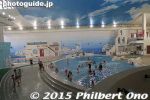
Hakone Kowakien Yunessan's main bath for bathing suits.
|
|

Hawai Onsen bus stop has this foot bath.
|
|

This is the wine bath. It does smell like wine. I didn't dare taste it, and there's a sign saying not to drink the water. This bath used to be outdoors, but now totally indoors which was disappointing.These flavored baths are for both men and women in bathing suits.
|
|

Hawai Onsen was built on reclaimed land jutting over the lake where the natural hot spring water gushed out of the lake bottom. This reclaimed land now has a number of inns where guests can enjoy the hot spring water. Since "Hawai" sounds the same as "Hawaii", it has associated itself with Hawaii by holding a hula festival in July.
|
|

Tea bath
|
|

Near Hawai Onsen is a nice lakeside park.
|
|

Tea bath was nice.
|
|
|
|
|
|

Coffee bath. Mild aroma of coffee.
|
|

Lake Togo on an overcast, winter day.
|
|

Sake bath was not really sake (I tasted the water). Only a tiny trickle of sake was dripping into the bath.
|
|

Walking path around Lake Togo.
|
|

Also popular was the "Doctor Fish" foot bath. These little fish come and eat away your feet's unwanted skin flakes.
|
|

Manhole for Yurihama town, Tottori Prefecture. Famous for Hawai Onsen, Togo Onsen, and Lake Togo.
|
|

People (kids) who had healthy skin did not attract much fish. It's really ticklish.
|
|

This lakefront space is used for the Hawaiian festival held in July.
|
|

About Doctor Fish
|
|

At the tip of the Hawai Onsen's reclaimed land jutting into the lake is an inn named Sennentei, one of the major inns.
|
|

Outdoor cavern bath
|
|

Hawai Onsen got its start in 1843 when local fishermen noticed warm spring water gushing out the lake bottom. The local Tottori lord gave them permission to utilize the hot spring water to make it easier to boil water, etc.
|
|

Outdoor slides at Yunessan.
|
|

In 1866, a former samurai stuck bamboo pipes into the lake bottom and was able to extract the hot spring water into a barrel on a boat above. It was an open-air spring bath on the rocking boat. This continued for some years until they finally reclaimed some land offshore in 1886 and drew the hot spring water directly below and even built a ryokan inn above. This was the start of commercial operations as "Asozu Onsen" (浅津温泉).
|
|

Bridge to Sennentei. I decided to bathe in their outdoor bath. Most of the inns have baths for visitors costing up to ¥1,000. 千年亭
|
|

Sennentei had a nice New Year's decoration with kadomatsu and tanuki. 千年亭
|
|

Sennentei had a nice New Year's decoration with kadomatsu and tanuki. 千年亭
|
|

Inside, Sennentei had a nice flower arrangement.
|
|

Sennentei lobby.
|
|
|
|

Bathing fees for non-staying guests. ¥1,000 for adults. Towels for rent too.
|
|

Men's outdoor bath at Sennentei. (Segregated) Hawai Onsen, Tottori. 千年亭
|
|

Men's outdoor bath at Sennentei. Nice view of the lake. Hawai Onsen, Tottori. 千年亭
|
|

Gift shop at Sennentei.
|
|

Gift shop at Sennentei sells Hawaiian chocolate.
|
|

Another large inn at Hawai Onsen is Bokoro. 望湖楼
|
|

This onsen had several name changes. In 1927, "Asozu Onsen" was renamed "Shin-Togo Onsen" (新東郷温泉). In 1978, it was renamed "Hawai Onsen" (羽合温泉). In 1998, they changed the Japanese name to はわい温泉 replacing the "hawai" kanji with hiragana.
|
|

Gift shop near the bus stop back to Kurayoshi Station.
|
|

Inside the Gift shop.
|
|

Autographed daruma.
|
|

Local souvenirs.
|
|

Yurihama poster
|
|

"Hawai" branch of this shop.
|
|

Main entrance to Spa Resort Hawaiians, a huge water park and onsen hot spring amusement facility built in 1966. I visited for the first time shortly after they reopened on Feb. 8, 2012.
|
|

One wing of Hotel Hawaiians was still undergoing repairs to cracks.
|
|

The new Monolith Hotel opened on Feb. 8, 2012.
|
|

After completing earthquake repairs, the water park re-opened on Feb. 8, 2012. Admission was half price.
|
|

Layout of Spa Resort Hawaiians.
|
|
|
|
|

From JR Yumoto Station, free shuttle buses run to Spa Resort Hawaiians.
|
|

The huge water park at Spa Resort Hawaiians. All the water is from a hot spring. The pool water is lukewarm.
|
|

The whole water park is heated to tropical temperatures even when it is freezing outside.
|
|

The water slides cost extra money. 200 yen per slide.
|
|
|
|
|
|
|
|
|
|
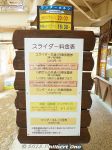
The water slides cost extra money. 200 yen per slide or a day pass for 2,200 yen.
|
|
|
|

Wading pool.
|
|

Wading pool.
|
|
|

Besides the pools, there are real hot spring baths where you have to go in naked. Cameras not allowed though.
|
|

Spring Park, a lukewarm hot spring pool.
|
|

Spa Garden Pareo has outdoor pools and a sauna. In winter, the air is freezing cold.
|
|
|

Statue of King Kamehameha even!
|
|

Hula lesson for kids at the Beach Theater in the Water Park.
|
|

Hula lesson for kids at the Beach Theater in the Water Park.
|
|
|
|
|

Beach Theater shows are free, but they also sell tickets for the best seats for ¥600 to ¥800.
|
|

Colored seats are reserved and cost extra.
|
|

Hula Girl Polynesian Revue at 1:30 pm to 2:15 pm at the Beach Theater.
|
|
|
|
|
|
|
|

The live band were all Japanese. All the dancers were Japanese and most are from Fukushima.
|
|

Fire knife dancers are the highlight and crowd pleasers. They are Japanese, but well-trained and highly skilled with the fire.
|
|
|
|
|
|
|

Great dancers and great show!
|
|
|
|
|
|
|
|
|
|
|
|
|
|
|
|

This is Maluhia Yukari, the leader of the hula girls. She was a pivotal in taking the lead following the 3/11 disasters and promoting Spa Resort Hawaiians on tour. She retired in June 2012. マルヒア由佳理
|
|
|
|
|

At the end of the show, people who paid for reserved seats could have their picture taken with the hula girls.
|
|

My video of Spa Resort Hawaiians. Visit Fukushima, visit Spa Resort Hawaiians!
|
|

The following pictures were taken in an earlier year (not 2009). Hakone Daimyo Gyoretsu Procession starts at Yumoto Elementary School at 10 am. 湯本小学校
|
|

The procession reenacts the daimyo procession of Okubo Kaga, lord of Odawara on his way to Edo (Tokyo) for the periodic sankin kotai procession.
|
|

Ladies in waiting. These pictures were taken some time ago (not in 2009). Since I saw it, the procession has gotten larger with more groups.
|
|
|
|
|
|
|
|
|

The daimyo lord is carried in a palanquin for the Hakone Daimyo Gyoretsu Procession. 大名駕籠
|
|
|

Hakone Tourism Companions
|
|

Yumoto Elementary School
|
|

Before the feudal lord procession, there are normal people in dance groups, etc.
|
|
|

The start of the Daimyo Procession. You hear, "Shitaaaa-niii, shitaaaa-niiii" (Go down, go down!) by the tsuyu-harai dew sweepers who lead the way to tell people to clear the way and bow in respect. 下ニー 下ニー
|
|

These men are the luggage carriers carrying the hasami-bako boxes containing clothing and other necessities. Hakone Daimyo Gyoretsu. 挟み箱
|
|

The Hakone Daimyo Gyoretsu Procession started in 1935 on the occasion of the Yumoto Expo. Except for the war years in the 1940s, this festival has been held annually.
|
|
|

Luggage carriers carrying the hasami-bako boxes containing clothing and other necessities. 挟み箱
|
|

These men are the keyari who carry fluffy-topped poles and toss the poles to each other. 毛槍
|
|

These men are the keyari who carry fluffy-topped poles and toss the poles to each other. 毛槍
|
|

The daimyo feudal lord in Hakone Daimyo Gyoretsu Procession.
|
|
|

Ladies in waiting. 奥女中
|
|
|
|

She was definitely the focal point of the procession before they started using a celebrity to play the daimyo. They past Yumoto Station in the background in the Hakone Daimyo Gyoretsu Procession.
|
|

Crossing Yumoto Ohashi Bridge
|
|
|

A large crowd watch the procession cross the Yumoto Ohashi Bridge. The parade ended at 2:30-3 pm.
|
|

Hakone Daimyo Gyoretsu Procession poster. To get to Hakone Yumoto, take the Odakyu Line Romance Car from Shinjuku. A cheaper but longer way is to take the Odakyu Line to Odawara, then take the Hakone Tozan Railway train to Hakone Yumoto Station.
|
|

Main venue of the Ikaho Merrie Monarch Hawaiian Festival held every summer in Ikaho Spa, Gunma Prefecture since 1997. It is on a city-operated parking lot. 伊香保ハワイアンフェスティバル会場
|
|

The main venue has two large adjoining tents. The tent on the left covers the stage, and the one on the right covers the audience seats. The place is ringed by outdoor shops selling Hawaiian goods (mainly clothing).
|
|

About 600 seats at the main venue. Ikaho's connection to Hawaii lies with the summer residence of Robert Walker Irwin, the Hawaiian Minister to Japan during the late 19th century.
|
|

The Hawaiian festival's opening ceremony was held on the festival's first day on Aug. 3, 2008. Among Japan's many hula festivals, this one is unique since it is organized by a city government based on sister-city ties.
|
|

The opening ceremony included a few speeches and a ukulele performance by Mr. San'uemon Chigira, the chairman of the festival committee.
|
|

Short greetings by Luana Saiki-Kawelu, Assistant Director of the Merrie Monarch Festival in Hilo, Hawaii. Ikaho's Hawaiian festival is Japan's only hula event officially endorsed by the Merrie Monarch Festival in Hilo.
|
|
| 1400 files on 6 page(s) |
1 |
 |
 |
 |
|